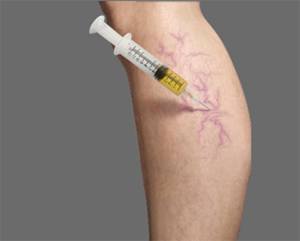Injection Sclerotherapy for Leg Vessels

Sclerotherapy is the primary treatment for small- vessel varicose disease of the lower extremities. It is a procedure used to treat blood vessel malformation and also those of the lymphatic system.
Varicose veins are blood vessels that are abnormally dilated which appear swollen, twisted and can be painful. They occur most commonly in the legs and feet. Telangiectasia otherwise known as spider veins are the smaller, flat, abnormally dilated blood vessels visible on the skin. Varicose and spider veins are blue, purple, or red veins appearing on the legs and calves. These are much more common in women, and can occur with pregnancy, trauma, obesity, as well as long periods of sitting or standing.
Indications
Sclerotherapy is indicated for various conditions including telangiectasis or venulectasias (spider veins), reticular ectasias (feeder veins), varicose veins, night cramps, swelling or aching legs.
Procedure
Sclerotherapy for leg veins has a success history of more than 20 years. This technique involves injecting a sclerosing substance, a mild detergent solution, directly into the vein using a very fine needle. The procedure takes about 15 to 30 minutes. You may experience a pin prick sensation with mild discomfort and cramping during the injection. The sclerosing solution irritates the lining of the blood vessel causing the vein to swell and stick together. Over time, the venous blemishes turn into scar tissue and may disappear.
The number of veins treated in one session will be decided by your dermatologist based on the size and location of the veins. There will be a two week interval between first and second treatments and then a 1-month period to assess response.
Scelotherapy slowly clears leg veins and may be completely resolved in two to six months, depending on the vessel size.
Side effects
Sclerotherapy injection may cause certain side effects such as itching, bruising, inflammation, appearance of brown lines, or development of new blood vessels at the site of injection. If the injection is done to larger veins, the veins may become hard and lumpy. These untoward effects may last for few days and disappear later.
If you notice any of the following side effects such as inflammation, sudden onset of swelling in leg, or ulcers at site of injection, contact your dermatologist immediately.
Precautions before scelotherapy
- Dermatologists recommend avoiding use of certain medications including aspirin, ibuprofen, over the counter drugs, herbs and dietary supplements. Discuss all medications you are currently taking with your dermatologist prior to undergoing sclerotherapy treatment.
- Avoid applying any lotions prior to treatment. If applied, discuss with your dermatologist.
Instructions after the procedure
After the treatment, follow the instructions of your dermatologist for the best results.
- The most important thing for you to do after sclerotherapy treatment is to walk to improve blood circulation in your legs.
- Leave dressings, if present, on for a minimum of 30 minutes.
- Wear support hosiery to compress the treated vessels.
- Use of aspirin, ibuprofen and other anti-inflammatory medications should be avoided within 48 hours after treatment.
- Avoid hot baths, hot compresses and direct exposure to sunlight.
- The injection sites may be washed using mild soap and tepid water.
- Avoid strenuous activities for the first 48 hours.
- Regular exercise and weight control are recommended between treatments.
